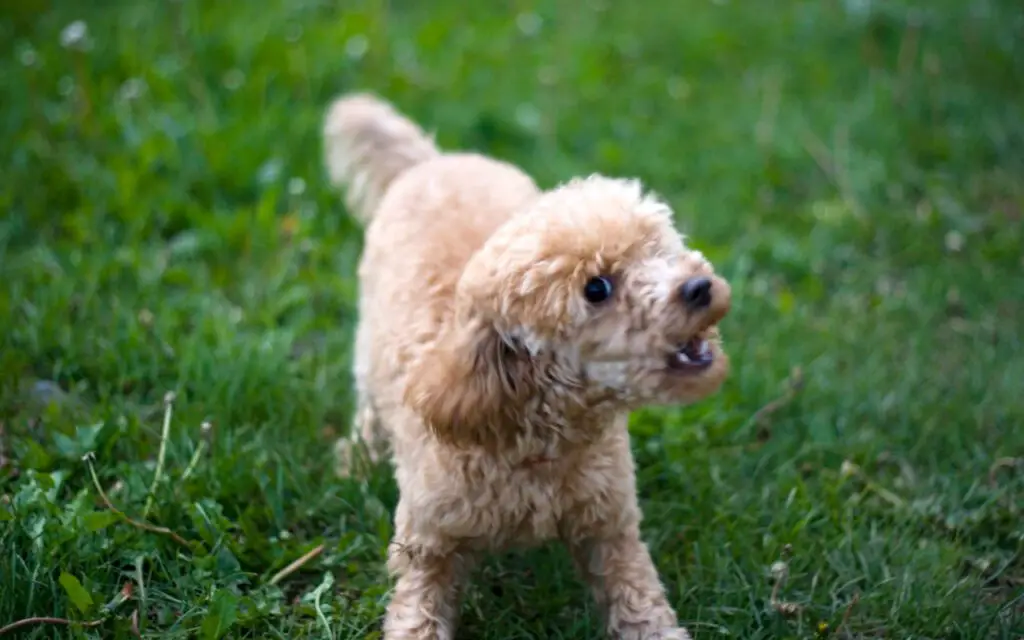Rabies is a deadly virus that affects the central nervous system of mammals, including dogs. Once symptoms appear, rabies is almost always fatal.
Therefore, it’s vital to recognize the signs as early as possible to protect your pet and prevent the potential spread of the disease.
The following 16 symptoms may indicate that your dog has contracted rabies.
These symptoms can vary widely and may appear anywhere from a few days to several months after exposure to the virus.
If you notice any of these signs in your dog, seek immediate veterinary attention.
- 16 Signs Your Dog Has Rabies
- Increased sensitivity to sound, light, and touch
- Inability to close the eyes
- Fever
- Difficulty swallowing
- Excessive drooling
- Staggering or lack of coordination
- Seizures
- Paralysis, often starting in the rear legs and moving forward
- Major behavior changes like becoming very agitated, easily stimulated, fearful, and aggressive
- Lethargy
- Vomiting
- Odd behaviors, possibly including uncharacteristic affection or aggression
- Progressive paralysis
- Facial distortion, such as a dropped jaw
- Fearfulness, even in familiar surroundings or situations
- Unusual shyness or aggression
- How Long Does It Take To Show Signs of Rabies In a Dog?
- How Is Rabies Diagnosed In Dogs
- Will a Dog With Rabies Drink Water?
- In Conclusion
Key Takeaway
- Signs that your dog may have rabies include heightened sensitivity to sound, light, and touch, difficulty swallowing, excessive drooling, staggering gait, seizures, and paralysis.
- It generally takes between 2-8 weeks for a dog to show signs of rabies after being infected, although symptoms can appear as early as a few days or as late as several months after exposure.
- Rabies in dogs is typically diagnosed through a combination of clinical signs, history of exposure to a rabid animal, and laboratory tests such as the direct fluorescent antibody test (DFAT) or polymerase chain reaction (PCR) test.
- A dog with rabies can drink water, although they may exhibit a fear of water due to neurological symptoms associated with the virus.
16 Signs Your Dog Has Rabies

- Inability to close the eyes
- Fever
- Difficulty swallowing
- Excessive drooling
- Staggering or lack of coordination
- Seizures
- Paralysis, often starting in the rear legs and moving forward
- Major behavior changes like becoming very agitated, easily stimulated, fearful, and aggressive
- Lethargy
- Vomiting
- Odd behaviors, possibly including uncharacteristic affection or aggression
- Progressive paralysis
- Facial distortion, such as a dropped jaw
- Fearfulness, even in familiar surroundings or situations
- Unusual shyness or aggression.
Increased sensitivity to sound, light, and touch
A dog with rabies may exhibit hypersensitivity to stimuli. They may react strongly to loud noises, bright lights, or even gentle touches that they would normally tolerate.
Inability to close the eyes
Rabies can cause muscle dysfunction, which may result in a dog’s inability to close its eyes. This can lead to dryness and potential damage to the eye.
Fever
An early symptom of rabies is a fever, as the body tries to fight off the infection.
Difficulty swallowing
Rabies affects the nervous system, which can lead to difficulty in swallowing. This is often why rabid animals drool excessively.
Excessive drooling
Rabies can cause paralysis of the throat and jaw muscles, leading to drooling. The dog may also foam at the mouth.
Staggering or lack of coordination
Neurological damage caused by rabies can lead to a lack of coordination. The dog might stagger or seem disoriented.
Seizures
Rabies can cause seizures due to its severe impact on the brain and nervous system.
Paralysis, often starting in the rear legs and moving forward
As rabies progresses, it can cause paralysis starting from the hind limbs and then moving forward to other parts of the body.
Major behavior changes like becoming very agitated, easily stimulated, fearful, and aggressive
Rabies can significantly alter a dog’s behavior. They might become unusually agitated, easily stimulated, fearful, or even aggressive.
Lethargy
In the later stages of rabies, dogs may become lethargic due to the toll the disease takes on their bodies.
Vomiting
Nausea and vomiting can occur as the disease progresses, likely due to its effect on the gastrointestinal system.
Odd behaviors, possibly including uncharacteristic affection or aggression
Dogs with rabies may exhibit odd behaviors that are out of character, such as unexplained aggression or overly affectionate behavior.
Progressive paralysis
Rabies eventually leads to progressive paralysis. This is typically a sign that the disease has reached its advanced stages.
Facial distortion, such as a dropped jaw
Rabies can cause facial distortion in dogs, such as a dropped jaw, due to muscle paralysis caused by the disease.
Fearfulness, even in familiar surroundings or situations
Changes in the brain caused by rabies can lead to heightened fear or anxiety, even in familiar surroundings or situations.
Unusual shyness or aggression
Rabies can cause major behavioral changes in dogs, including unusual shyness or aggression. This is due to the disease’s effect on the brain and nervous system.
How Long Does It Take To Show Signs of Rabies In a Dog?

Most often, signs of rabies in dogs will start to appear within 3 to 12 weeks of exposure to the virus.
However, this timing can be influenced by factors such as the location of the initial virus entry, the amount of virus introduced, and the individual dog’s immune response.
Once symptoms begin to appear, the disease progresses rapidly.
Therefore, it’s important to seek immediate veterinary care if you suspect your dog has been exposed to rabies, even if they are not yet showing signs.
Regular vaccination is the most effective way to protect dogs from contracting rabies.
How Is Rabies Diagnosed In Dogs
Rabies in dogs is typically diagnosed using a test called the Direct Fluorescent Antibody (DFA) test, according to sources like the Centers for Disease Control and Prevention (CDC).
This test looks for the presence of rabies virus antigens in brain tissue.
However, it’s important to note that this test can only be performed post-mortem, meaning the animal must be deceased.
This is due to the fact that the test requires a sample of brain tissue, which cannot be obtained from a living animal without causing severe harm or death.
If there is a strong suspicion that a living dog may have rabies based on symptoms and history (such as known exposure to a rabid animal), the dog is usually quarantined and observed for signs of the disease.
If the dog develops symptoms consistent with rabies, it may be euthanized and then tested using the DFA test.
In some cases, other tests may be used in an attempt to diagnose rabies in a living animal.
These can include testing samples of saliva, serum, spinal fluid, and skin biopsies of hair follicles at the nape of the neck.
However, these tests are less reliable than the DFA test, and a negative result does not rule out rabies.
Will a Dog With Rabies Drink Water?
Yes, a dog with rabies can drink water. However, as the disease progresses, the dog may develop symptoms such as difficulty swallowing and fear of water, also known as hydrophobia.
This is due to the virus causing inflammation in the brain, which can lead to a fear of swallowing anything, including water, known as dysphagia.
It’s important to note that the term “hydrophobia” is somewhat misleading when it comes to dogs. Unlike humans with rabies, dogs do not typically exhibit a fear of water. Instead, they may simply have difficulty drinking due to the paralysis of throat muscles.
Moreover, it’s very unlikely for dogs to contract rabies from sharing drinking water. The primary mode of rabies transmission is through the bite of an infected animal, not through ingestion of contaminated water or food.
FAQs
Q: Can my dog get rabies from other animals?
A: Yes, rabies is typically transmitted through the bite of an infected animal. Common carriers of the virus include bats, raccoons, skunks, and foxes.
Q: How long does it take for symptoms to appear if my dog has been infected with rabies?
A: The incubation period for rabies can vary, but symptoms typically appear within 3 to 8 weeks after exposure.
Q: Can my dog be vaccinated against rabies?
A: Yes, it is recommended that all dogs be vaccinated against rabies. Vaccination can help protect your dog from contracting the virus and can also be required by law in many areas.
Q: Are there any risks associated with the rabies vaccine?
A: Like any vaccine, there may be some minor risks associated with the rabies vaccine. Most dogs tolerate the vaccine well, but some may experience mild side effects such as soreness at the injection site or lethargy. Serious adverse reactions are rare.
Q: What should I do if my dog has been bitten by a potentially rabid animal?
A: If your dog has been bitten by a potentially rabid animal, it is important to seek veterinary care immediately. Your vet will be able to assess the situation and may recommend post-exposure prophylaxis or additional precautions.
Q: Can I get rabies from my dog?
A: While it is possible for humans to contract rabies from an infected dog, it is extremely rare. Most cases of rabies in humans are caused by bites from wild animals.
Q: Is there a cure for rabies?
A: Currently, there is no known cure for rabies once symptoms appear. It is therefore important to take preventative measures such as vaccination to protect your dog.
Q: Can indoor dogs get rabies?
A: While the risk may be lower for indoor dogs, it is still possible for them to contract rabies if they come into contact with an infected animal, such as a bat that has found its way into the home.
Q: Can I prevent my dog from getting rabies?
A: Yes, there are several steps you can take to help prevent your dog from getting rabies. These include regular vaccination, avoiding contact with potentially infected animals, and keeping your dog securely contained and supervised when outdoors.
In Conclusion
In conclusion, recognizing the 16 signs of rabies in dogs is crucial for early detection and prompt medical intervention.
Rabies is a serious and fatal disease that not only affects your pet’s health but also poses a significant risk to humans and other animals.
Therefore, it’s important to ensure regular vaccinations for your dog as a preventive measure.
If you notice any of these symptoms in your dog, seek immediate veterinary attention to safeguard the health of your pet and those around you.





Leave a Reply